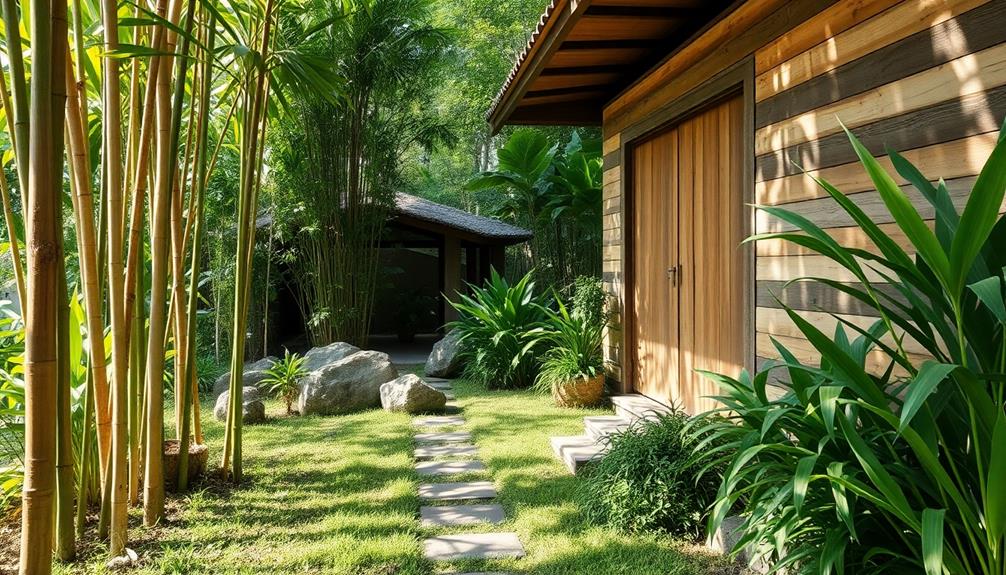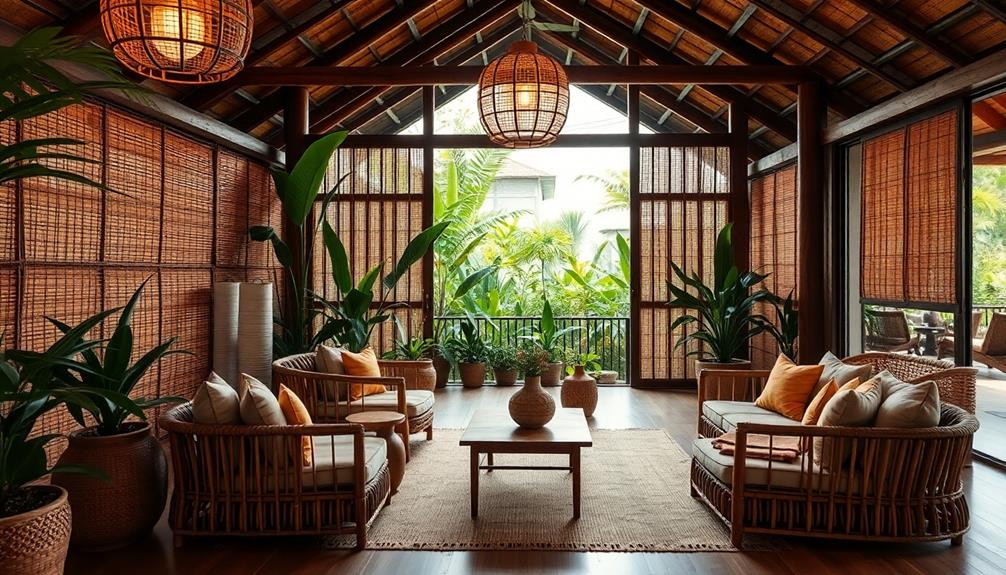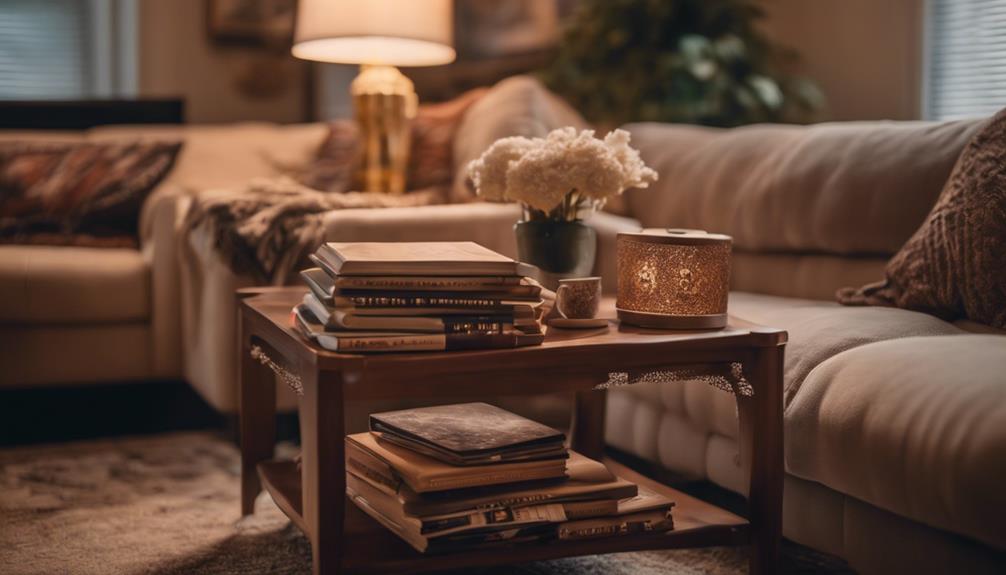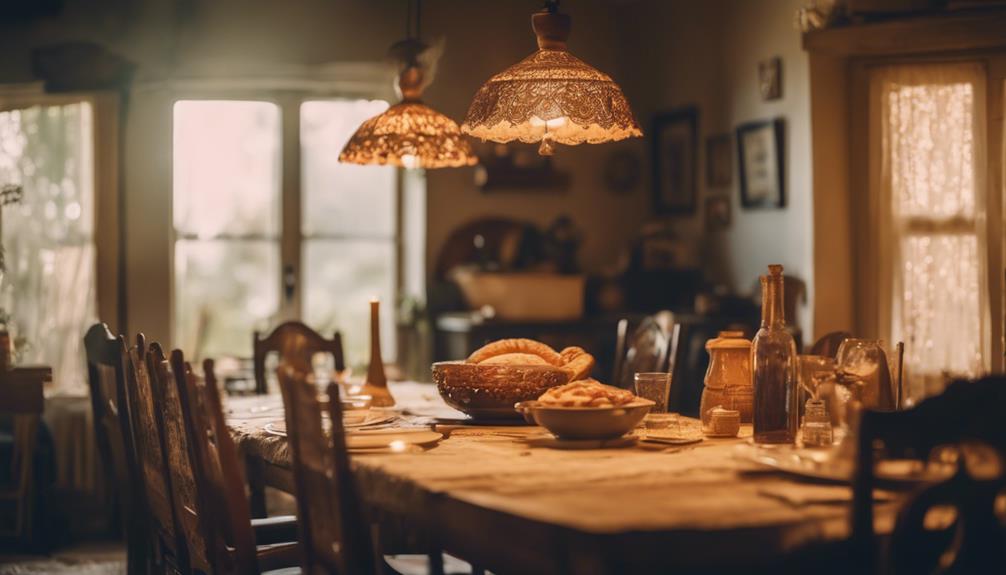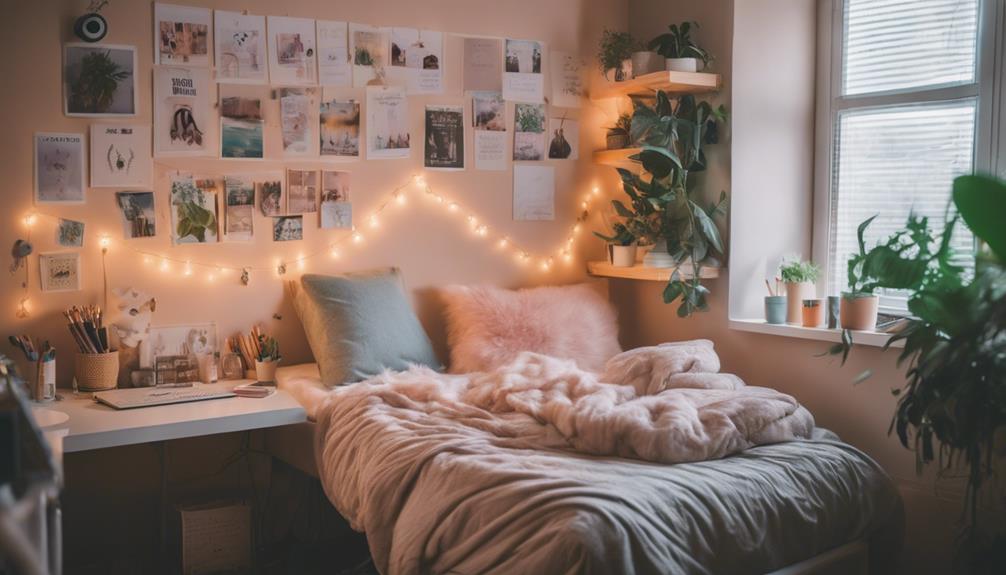Indonesia's best eco-friendly design materials include bamboo, reclaimed wood, and innovative uses of plastic waste. Bamboo stands out for its rapid growth and strength, making it ideal for construction. Reclaimed wood not only reduces waste but brings a unique character to your designs. In response to plastic pollution, creative companies produce stunning items from shredded plastic waste, promoting sustainability. Don't overlook natural fabrics like rattan and upcycled textiles that add charm while being biodegradable. Embracing these materials aligns with eco-conscious trends, and there's so much more to discover about sustainable practices in Indonesia's design scene.
Key Takeaways
- Bamboo is a fast-growing, versatile material with strong tensile strength and natural pest resistance, ideal for sustainable architecture.
- Reclaimed wood, sourced from demolished structures, reduces waste and adds unique aesthetic value to designs.
- Innovative uses of plastic waste, such as artistic products and biodegradable packaging, address plastic pollution sustainably.
- Natural fabrics like rattan, cotton, and hemp promote eco-friendly fashion, utilizing plant-based dyes to reduce chemical pollution.
- Sustainable building practices in Bali prioritize local materials, fostering community skills and enhancing indoor air quality through eco-friendly options.
Overview of Eco-Friendly Materials
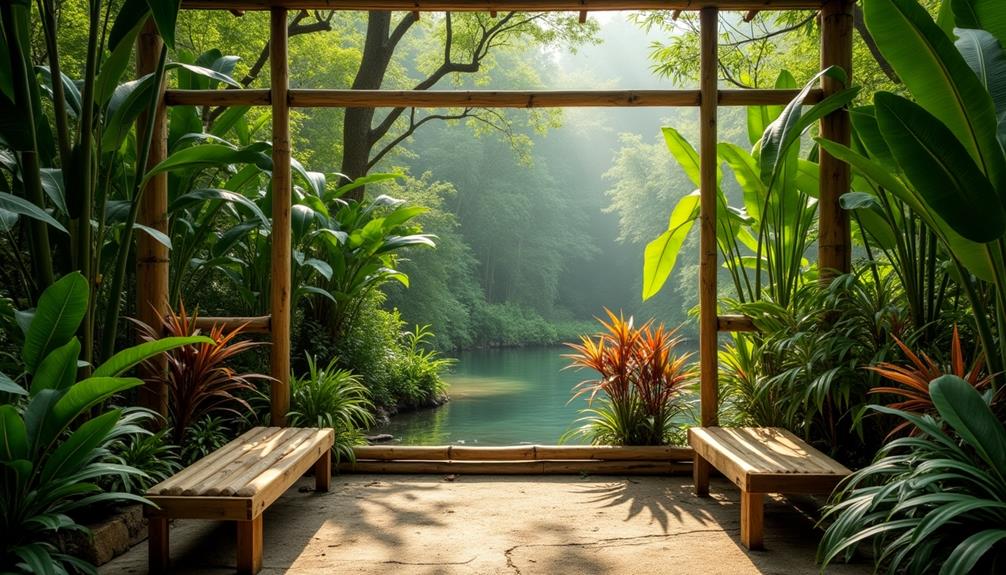
In recent years, eco-friendly materials have gained significant attention in Indonesia's design landscape. You'll find that sustainable materials, such as bamboo, coconut wood, and thatch roofing, are becoming increasingly popular.
Bamboo is particularly remarkable; it grows at a rapid rate of 1.5 inches per day and serves multiple purposes, including structural supports and flooring. Its renewability makes it an ideal choice for eco-conscious designs, aligning well with Balinese interior design concepts that emphasize natural materials and sustainability.
Balinese design characteristics also reflect a commitment to eco-friendly practices.
Coconut wood is another sustainable material worth noting. As a byproduct of aging palm trees, it helps minimize waste while offering a unique natural aesthetic in furniture and flooring.
Thatch roofing, made from biodegradable materials like straw and palm leaves, not only provides excellent insulation but also complements traditional aesthetics with its eco-friendly attributes.
Teak wood is a strong contender as well, known for its durability and resistance to weather and pests. This makes it perfect for outdoor furniture without requiring harmful chemical treatments.
Finally, the innovative use of recycled materials, such as tires in footwear by companies like Indosole, highlights the creative approaches taken toward sustainability in Indonesia's design scene.
Bamboo: The Sustainable Wonder
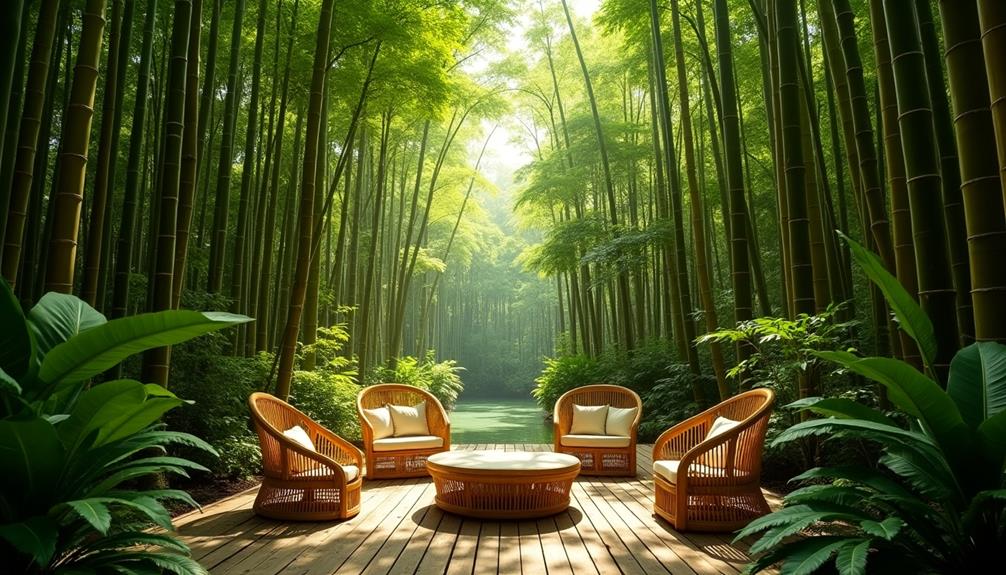
Often hailed as a sustainable wonder, bamboo stands out as one of the most versatile and renewable materials available today. Its use in traditional Indonesian housing showcases its cultural significance and adaptability.
You'll be amazed to learn that bamboo can grow up to 1.5 inches per day, making it an incredibly fast-growing resource for construction and design. Its strength is impressive too; with a tensile strength comparable to steel, bamboo is perfect for structural supports, flooring, and furniture.
One of the best features of this sustainable material is its natural resistance to pests and diseases. This means you won't need to rely on harmful chemical treatments, which contributes to a healthier living environment.
Additionally, bamboo plays an essential role in combating climate change, as it sequesters more carbon dioxide than many timber species during its growth.
The versatility of bamboo allows for a wide range of applications, from traditional thatch roofing to modern eco-friendly architecture. By incorporating bamboo into your projects, you're promoting sustainable design practices while enjoying a beautiful, functional material.
Whether you're building a home or furnishing a space, bamboo is an eco-conscious choice that supports a greener future.
Reclaimed Wood and Its Benefits
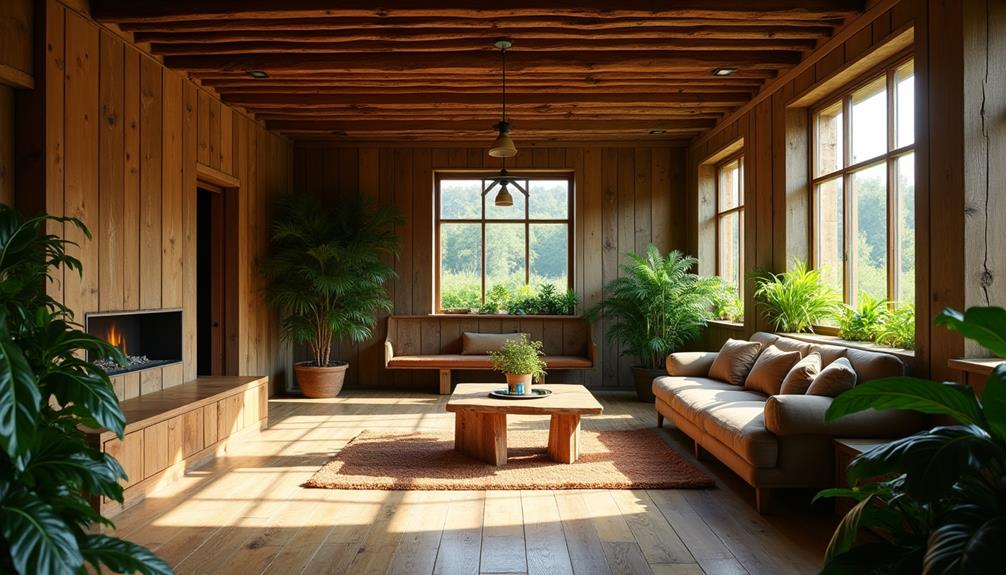
Bamboo's eco-friendly attributes set the stage for another sustainable material making waves in Indonesia: reclaimed wood. This remarkable resource is sourced from structures marked for demolition, which means it reduces waste and promotes sustainability by giving new life to materials that would otherwise end up in landfills.
In the context of Indonesian housing, the use of reclaimed wood aligns with the emphasis on local materials and sustainable practices, reflecting a commitment to both heritage and the environment traditional and modern elements. When you choose reclaimed wood for your projects, you're not just making a stylish choice; you're embracing a piece of history, as each plank features unique grain patterns, colors, and textures that add aesthetic value to your sustainable design.
By collaborating with companies like I-Rewood, you can guarantee that the reclaimed wood you use comes from verified sustainable sources, reinforcing its eco-friendly credentials.
Plus, using reclaimed wood in construction and decor considerably lowers the carbon footprint associated with new lumber production, as it requires less energy and resources to process.
Incorporating reclaimed wood into your designs not only supports environmental sustainability but also bolsters local economies by utilizing materials often found within the community.
Innovative Uses of Plastic Waste
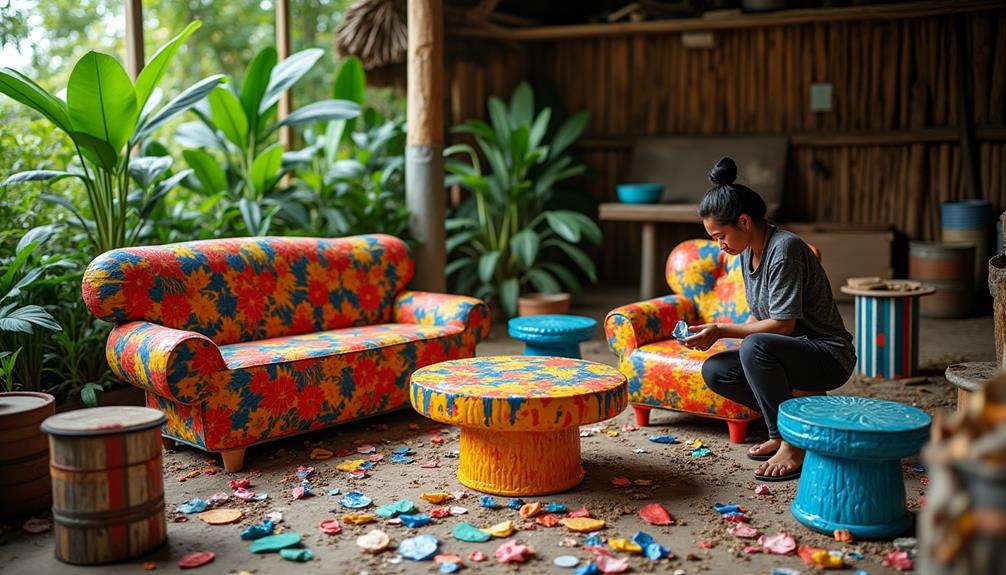
Transforming plastic waste into innovative products has become a vital aspect of sustainable design in Indonesia. Companies like DuaKala are leading the charge by turning shredded plastic waste into artistic creations, encouraging designers to explore new plastic molding techniques.
This collaboration sparks creativity while addressing the plastic crisis, much like the intricate designs found in traditional Indonesian decor masks that reflect the rich cultural heritage.
The rise of eco-friendly design also brings forward alternatives like reusable bottles from Bottle For Earth. These stylish solutions aim to replace single-use bottled water, promoting sustainable hydration and reducing waste.
Meanwhile, Bali's single-use plastic ban has inspired the hospitality industry to adopt eco-friendly alternatives, such as reusable containers and biodegradable amenities, greatly cutting down plastic waste.
In workshops like the Dynapack Innovation Workshop, companies are developing biodegradable packaging solutions using plant-based materials.
These sustainable materials leave no harmful contamination behind, demonstrating a strong commitment to environmental responsibility.
Natural Fabrics: Rattan and Beyond
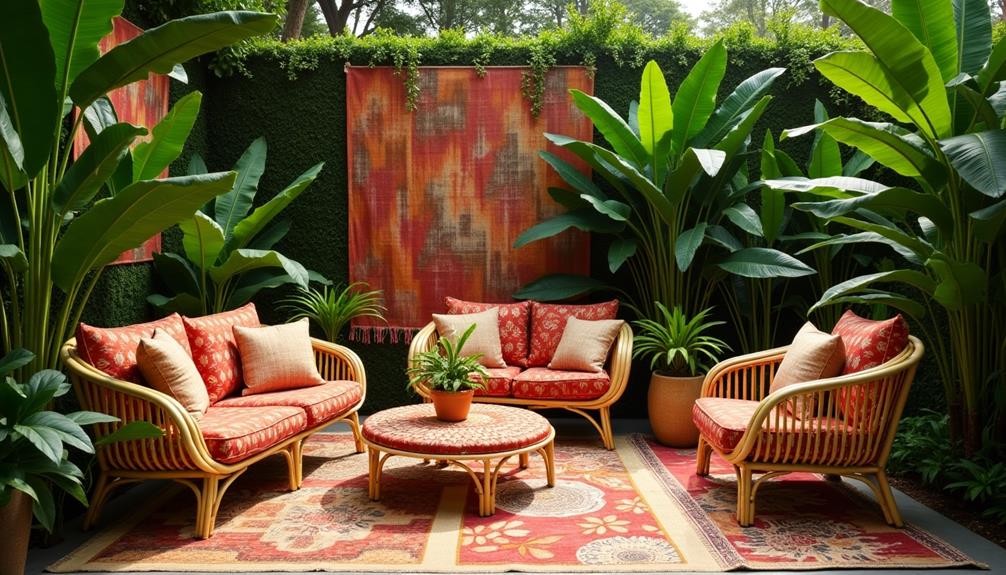
In the domain of eco-friendly design, natural fabrics like rattan are gaining recognition for their sustainability and versatility. Rattan, a rapidly renewable material, serves as an excellent choice for sustainable furniture and decor, often featured in Indonesian decorative pillows that enhance living spaces.
Indonesia, a major producer of rattan, relies heavily on this resource for its local crafts and exports, contributing to both the economy and eco-conscious living.
Beyond rattan, you'll find other natural fabrics that offer biodegradable properties and lower environmental impacts compared to synthetic fibers. These materials include:
- Cotton
- Linen
- Hemp
- Upcycled jute
- Banana fibers
The use of natural dyes derived from plants and minerals not only reduces chemical pollution but also enhances the aesthetics of eco-friendly textiles.
Innovations in sustainable practices are making it easier for designers to incorporate these materials into modern design, promoting waste reduction and encouraging eco-conscious consumerism.
By choosing natural fabrics, you support sustainable practices that respect the environment while enjoying beautiful, functional design.
Embrace these eco-friendly materials and contribute to a greener future.
Repurposed Materials in Fashion

Repurposing materials in fashion opens up a world of creativity and sustainability, allowing designers to craft unique pieces from what would otherwise be waste. For instance, companies like Indosole transform discarded tires into durable footwear, showcasing how repurposed materials can be stylish and functional.
Similarly, ArtCycleBALI creatively uses repurposed tires and inner tubes to produce fashionable accessories and jewelry, merging artistic expression with sustainability. Additionally, the use of traditional Indonesian decor masks can inspire designers to incorporate cultural elements into their work, emphasizing the importance of traditional artistry.
DuaKala takes a bold step by turning shredded plastic into valuable products, pushing designers to explore innovative uses of plastic waste. This not only elevates the design but also addresses the pressing issue of plastic pollution.
Rimmba emphasizes recycled and natural materials in apparel, promoting slow fashion practices that considerably reduce waste and environmental impact.
Moreover, brands like I-Rewood highlight the potential of reclaimed wood in fashion, demonstrating how materials that would typically end up as waste can be transformed into unique clothing and accessories.
Sustainable Building Practices in Bali
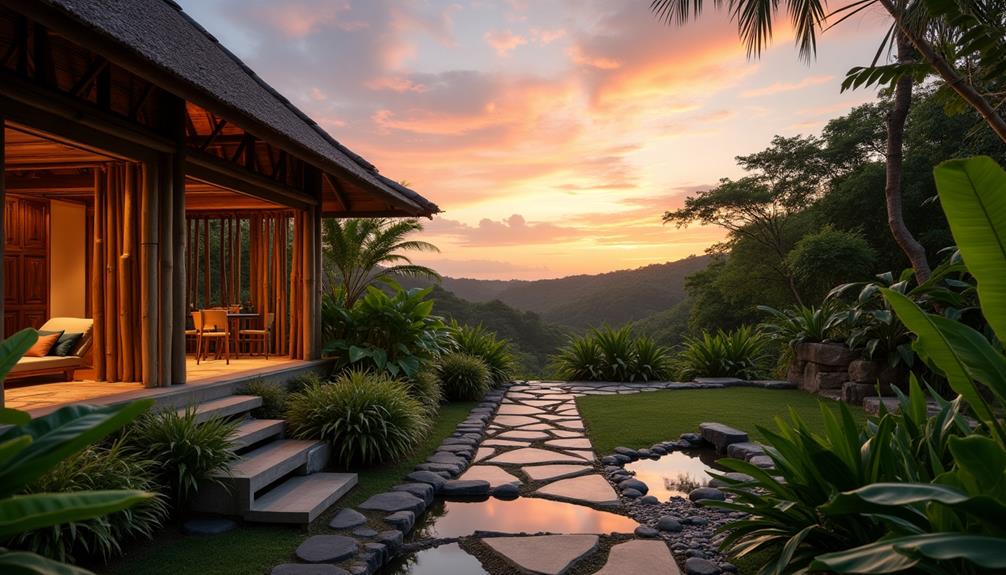
Sustainable building practices in Bali reflect a growing commitment to eco-friendly solutions, much like the innovative use of repurposed materials in fashion. The island has taken significant steps toward sustainability, particularly implementing a single-use plastic ban, the first in Indonesia. This initiative supports the hospitality industry in embracing sustainable alternatives, and many projects are designed with tropical villa plans that emphasize open spaces and natural light.
In Bali, you'll find an impressive use of local materials, especially bamboo. Known for its rapid growth and strength, bamboo is a staple in creating sustainable interiors. Eco-friendly accommodations, like Bambu Indah Resort, showcase this bamboo architecture, seamlessly integrating natural materials into the design.
Projects such as Fivelements Retreat exemplify a blend of traditional building techniques and modern eco-friendly practices. Additionally, organizations like Bamboo U play an essential role by offering training in bamboo construction methods, cultivating a community focused on sustainable building.
Here are some key aspects of Bali's sustainable building practices:
- Use of local materials
- Emphasis on bamboo architecture
- Integration of wellness and sustainability
- Community training programs
- Reduction of single-use plastics
These practices not only enhance the aesthetic appeal but also promote a more sustainable future for Bali.
Health Benefits of Eco Materials
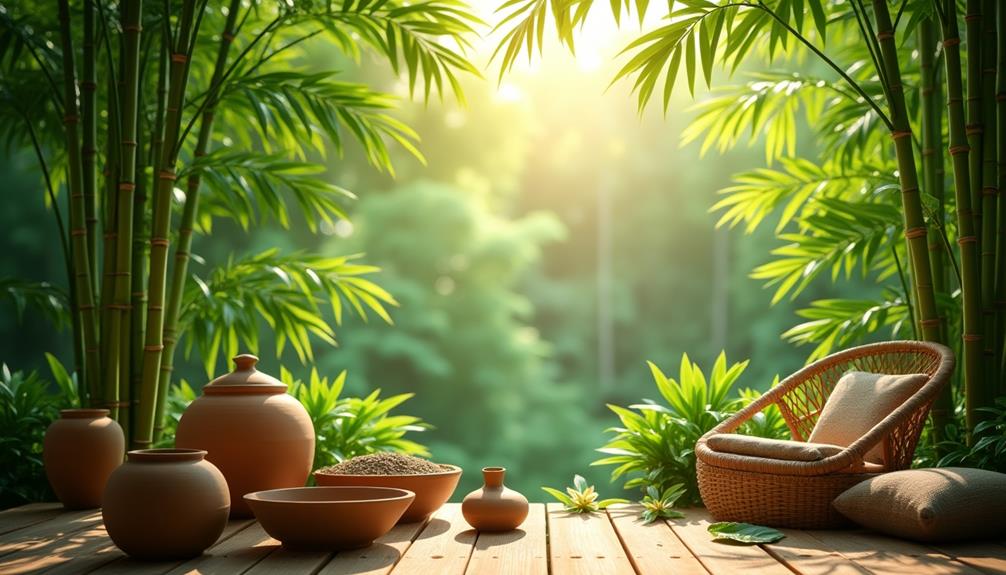
Choosing eco-friendly materials for your home not only supports the environment but also enhances your health and well-being. When you opt for materials like bamboo and coconut wood, you reduce the presence of volatile organic compounds (VOCs) in your space, which helps improve indoor air quality. This creates a healthier living environment for you and your family.
Additionally, integrating luxury tropical designs can elevate the aesthetic appeal of your home while using sustainable materials. Sustainable materials such as teak wood come with natural pest resistance, which means you won't need harmful chemical treatments that can negatively impact your health.
Furthermore, thatch roofing offers natural insulation, regulating indoor temperatures to enhance comfort while lowering energy costs. If you're concerned about allergies or asthma, incorporating hypoallergenic materials like bamboo can greatly lower these risks, providing a safer space for sensitive individuals.
By choosing natural, chemical-free eco-friendly materials, you promote overall well-being and create a lifestyle that minimizes exposure to environmental toxins. Incorporating these materials into your design not only beautifies your home but also fosters a healthier atmosphere for you and your loved ones.
Future Trends in Sustainable Design
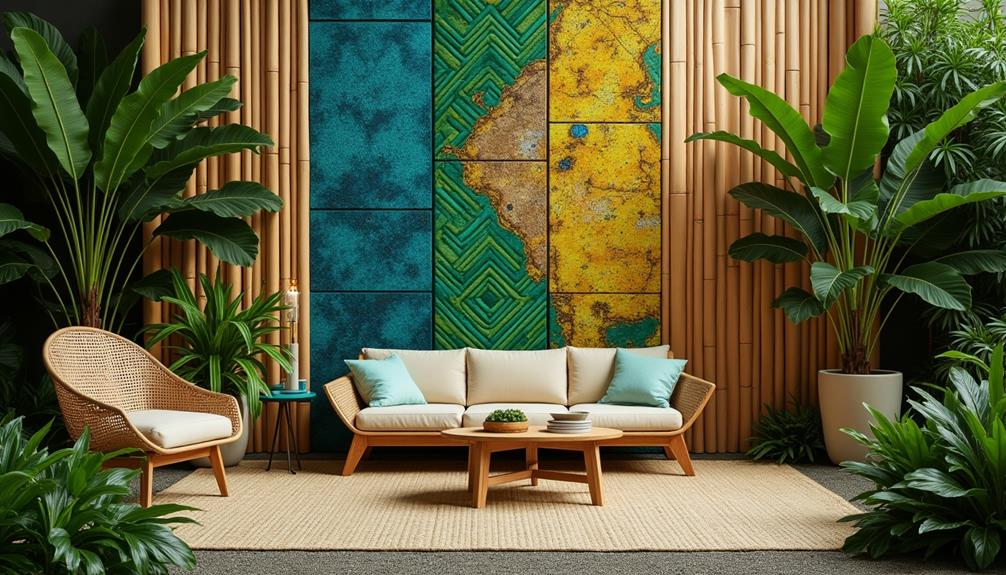
Embracing innovative materials and practices, the future of sustainable design in Indonesia is set to transform the architectural landscape.
You'll witness a surge in the use of sustainable materials, driven by consumer demand and regulatory changes. Mahallati Interiors' luxury tropical designs exemplify how natural elements can harmonize with eco-friendly practices.
Here are some key trends to watch for:
- Biodegradable Innovations: Expect to see more plant-based materials, like coffee capsules that decompose as quickly as banana skins.
- Single-Use Plastic Alternatives: The ban in Bali is pushing the hospitality industry towards more reusable and eco-friendly options.
- Bamboo and Reclaimed Timber: Designers are increasingly opting for these sustainable materials, aligning with global green building trends.
- Circular Economy: Companies are adopting closed-loop systems, promoting the use of recycled materials to minimize waste.
- Biophilic Design: Integrating nature into design will become more prevalent, enhancing well-being and connectivity with the environment.
As you explore these trends, you'll find that sustainable materials not only contribute to environmental goals but also create aesthetically pleasing spaces.
The shift in design practices signals a promising future for sustainability in Indonesia's architecture and beyond.
Frequently Asked Questions
What's the Most Eco-Friendly Building Material?
When considering the most eco-friendly building material, bamboo stands out due to its rapid growth, renewability, and versatility. It's perfect for structural supports, flooring, and roofing, making it a top choice for sustainable construction.
What Are the Sustainable Building Materials in Bali?
In Bali, you'll find sustainable building materials like bamboo, thatch roofing, coconut wood, and teak. These resources not only promote eco-friendly architecture but also enhance the region's natural beauty and cultural heritage.
What Material Is More Eco-Friendly?
You might think all materials are equally eco-friendly, but bamboo's rapid growth and sustainability set it apart. Choosing bamboo for your projects can greatly reduce your environmental impact while offering strength and versatility in design.
What Is the Best Eco-Friendly Country?
When considering the best eco-friendly country, you should look at Denmark, Sweden, and Norway. Each excels in sustainability through innovative practices, waste management, and renewable energy, showcasing their commitment to protecting the environment for future generations.
Conclusion
As you journey through Indonesia's lush landscapes, remember that eco-friendly materials are like seeds planted in the fertile earth of sustainable design. Each choice you make, from bamboo to reclaimed wood, nurtures a thriving ecosystem. By embracing these materials, you're not just building; you're cultivating a legacy for future generations. So, let your creativity bloom, and watch as your sustainable vision transforms into a vibrant tapestry, woven with nature's finest threads. Together, you can create a greener tomorrow.
